BUS707 Applied Business Research: AIS and Auditing in Retail Sector
VerifiedAdded on 2023/04/23
|13
|6892
|487
Report
AI Summary
This report investigates the impact of Accounting Information Systems (AIS) and auditing on the design of organizations and the subsequent behavior of individuals and groups, focusing on the Australian retail sector, particularly Woolworths Group Ltd. The study employs a descriptive research design with a questionnaire-based data collection method, surveying accountants and senior managers across approximately twenty Woolworths branch stores. Data analysis involves correlation and regression techniques using Microsoft Excel. The findings reveal a positive relationship between AIS implementation and the efficiency of the retail business, supporting effective decision-making, people management, and operational controls. The report recommends that retail industries incorporate well-structured AIS and integrated human resource support to enhance their financial and accounting systems, especially considering the increasing global market competition. The research highlights the importance of AIS for cost control and strategic decision-making within the context of a dynamic retail environment, emphasizing the need for automated processes to replace manual data management and reduce errors. The study also touches upon the challenges faced by Australian retailers, including the reorientation of the Chinese economy, increased competition, high taxation, and operational costs, and how AIS can help in mitigating these hindrances.
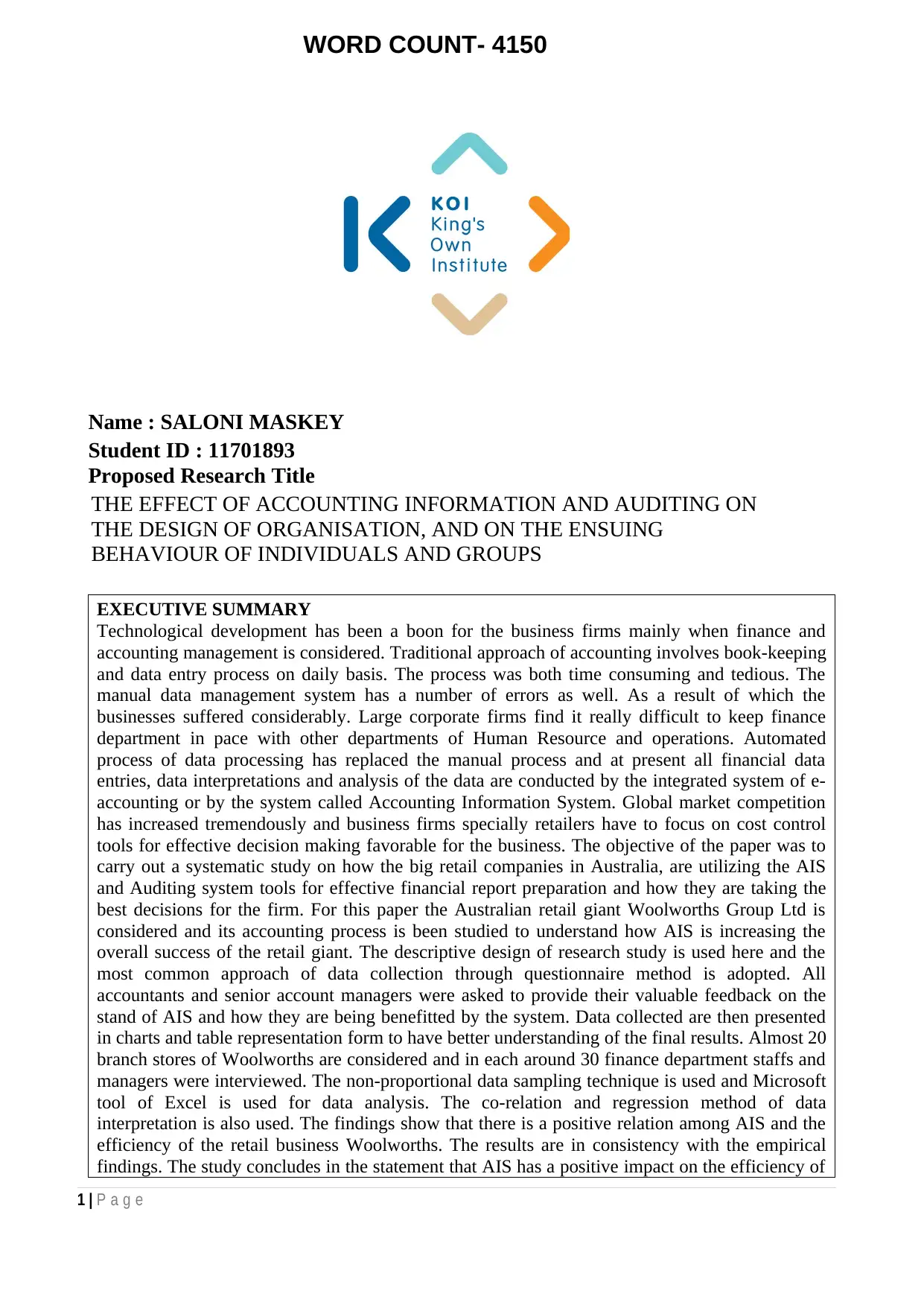
WORD COUNT- 4150
Name : SALONI MASKEY
Student ID : 11701893
Proposed Research Title
THE EFFECT OF ACCOUNTING INFORMATION AND AUDITING ON
THE DESIGN OF ORGANISATION, AND ON THE ENSUING
BEHAVIOUR OF INDIVIDUALS AND GROUPS
EXECUTIVE SUMMARY
Technological development has been a boon for the business firms mainly when finance and
accounting management is considered. Traditional approach of accounting involves book-keeping
and data entry process on daily basis. The process was both time consuming and tedious. The
manual data management system has a number of errors as well. As a result of which the
businesses suffered considerably. Large corporate firms find it really difficult to keep finance
department in pace with other departments of Human Resource and operations. Automated
process of data processing has replaced the manual process and at present all financial data
entries, data interpretations and analysis of the data are conducted by the integrated system of e-
accounting or by the system called Accounting Information System. Global market competition
has increased tremendously and business firms specially retailers have to focus on cost control
tools for effective decision making favorable for the business. The objective of the paper was to
carry out a systematic study on how the big retail companies in Australia, are utilizing the AIS
and Auditing system tools for effective financial report preparation and how they are taking the
best decisions for the firm. For this paper the Australian retail giant Woolworths Group Ltd is
considered and its accounting process is been studied to understand how AIS is increasing the
overall success of the retail giant. The descriptive design of research study is used here and the
most common approach of data collection through questionnaire method is adopted. All
accountants and senior account managers were asked to provide their valuable feedback on the
stand of AIS and how they are being benefitted by the system. Data collected are then presented
in charts and table representation form to have better understanding of the final results. Almost 20
branch stores of Woolworths are considered and in each around 30 finance department staffs and
managers were interviewed. The non-proportional data sampling technique is used and Microsoft
tool of Excel is used for data analysis. The co-relation and regression method of data
interpretation is also used. The findings show that there is a positive relation among AIS and the
efficiency of the retail business Woolworths. The results are in consistency with the empirical
findings. The study concludes in the statement that AIS has a positive impact on the efficiency of
1 | P a g e
Name : SALONI MASKEY
Student ID : 11701893
Proposed Research Title
THE EFFECT OF ACCOUNTING INFORMATION AND AUDITING ON
THE DESIGN OF ORGANISATION, AND ON THE ENSUING
BEHAVIOUR OF INDIVIDUALS AND GROUPS
EXECUTIVE SUMMARY
Technological development has been a boon for the business firms mainly when finance and
accounting management is considered. Traditional approach of accounting involves book-keeping
and data entry process on daily basis. The process was both time consuming and tedious. The
manual data management system has a number of errors as well. As a result of which the
businesses suffered considerably. Large corporate firms find it really difficult to keep finance
department in pace with other departments of Human Resource and operations. Automated
process of data processing has replaced the manual process and at present all financial data
entries, data interpretations and analysis of the data are conducted by the integrated system of e-
accounting or by the system called Accounting Information System. Global market competition
has increased tremendously and business firms specially retailers have to focus on cost control
tools for effective decision making favorable for the business. The objective of the paper was to
carry out a systematic study on how the big retail companies in Australia, are utilizing the AIS
and Auditing system tools for effective financial report preparation and how they are taking the
best decisions for the firm. For this paper the Australian retail giant Woolworths Group Ltd is
considered and its accounting process is been studied to understand how AIS is increasing the
overall success of the retail giant. The descriptive design of research study is used here and the
most common approach of data collection through questionnaire method is adopted. All
accountants and senior account managers were asked to provide their valuable feedback on the
stand of AIS and how they are being benefitted by the system. Data collected are then presented
in charts and table representation form to have better understanding of the final results. Almost 20
branch stores of Woolworths are considered and in each around 30 finance department staffs and
managers were interviewed. The non-proportional data sampling technique is used and Microsoft
tool of Excel is used for data analysis. The co-relation and regression method of data
interpretation is also used. The findings show that there is a positive relation among AIS and the
efficiency of the retail business Woolworths. The results are in consistency with the empirical
findings. The study concludes in the statement that AIS has a positive impact on the efficiency of
1 | P a g e
Paraphrase This Document
Need a fresh take? Get an instant paraphrase of this document with our AI Paraphraser
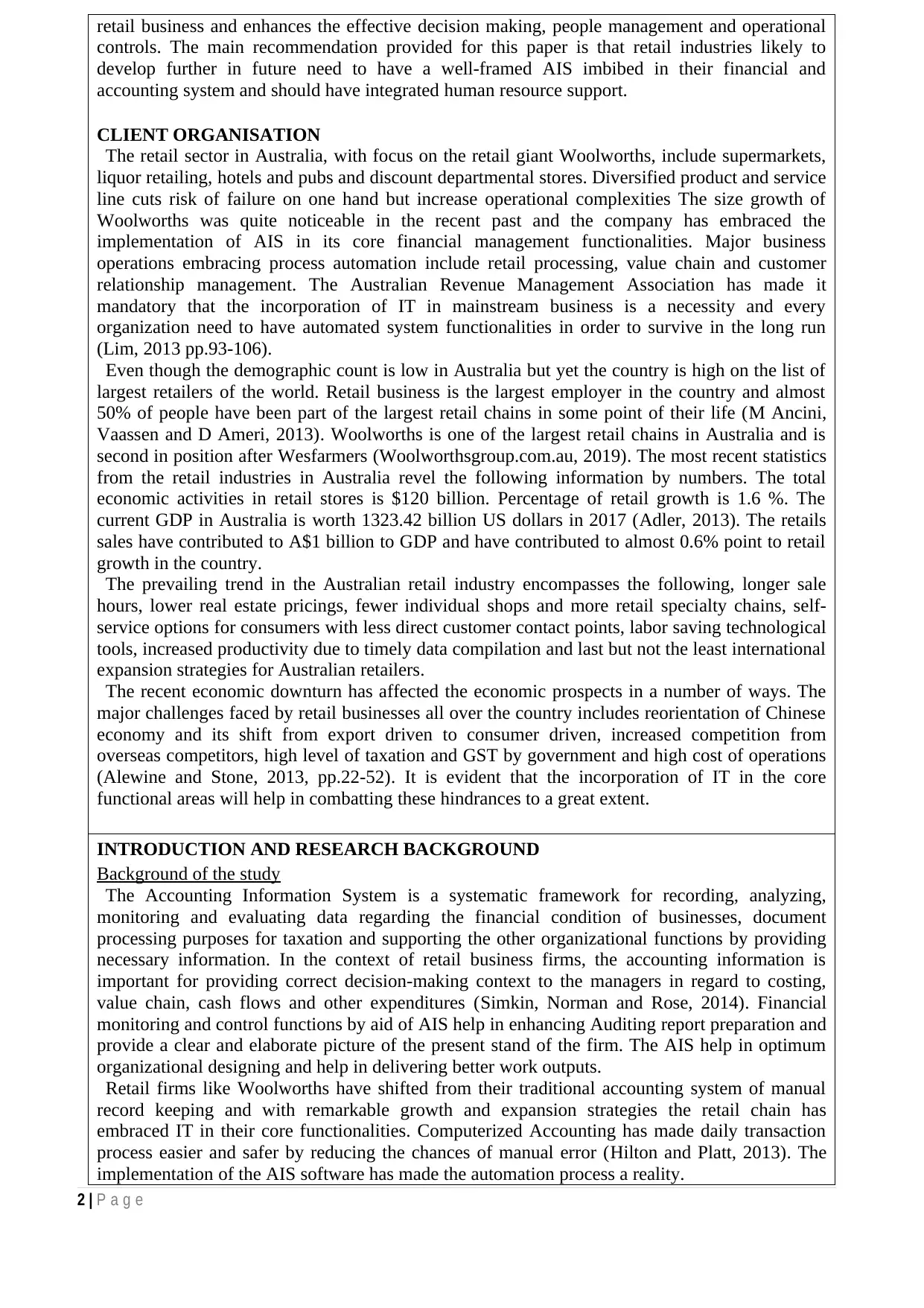
retail business and enhances the effective decision making, people management and operational
controls. The main recommendation provided for this paper is that retail industries likely to
develop further in future need to have a well-framed AIS imbibed in their financial and
accounting system and should have integrated human resource support.
CLIENT ORGANISATION
The retail sector in Australia, with focus on the retail giant Woolworths, include supermarkets,
liquor retailing, hotels and pubs and discount departmental stores. Diversified product and service
line cuts risk of failure on one hand but increase operational complexities The size growth of
Woolworths was quite noticeable in the recent past and the company has embraced the
implementation of AIS in its core financial management functionalities. Major business
operations embracing process automation include retail processing, value chain and customer
relationship management. The Australian Revenue Management Association has made it
mandatory that the incorporation of IT in mainstream business is a necessity and every
organization need to have automated system functionalities in order to survive in the long run
(Lim, 2013 pp.93-106).
Even though the demographic count is low in Australia but yet the country is high on the list of
largest retailers of the world. Retail business is the largest employer in the country and almost
50% of people have been part of the largest retail chains in some point of their life (M Ancini,
Vaassen and D Ameri, 2013). Woolworths is one of the largest retail chains in Australia and is
second in position after Wesfarmers (Woolworthsgroup.com.au, 2019). The most recent statistics
from the retail industries in Australia revel the following information by numbers. The total
economic activities in retail stores is $120 billion. Percentage of retail growth is 1.6 %. The
current GDP in Australia is worth 1323.42 billion US dollars in 2017 (Adler, 2013). The retails
sales have contributed to A$1 billion to GDP and have contributed to almost 0.6% point to retail
growth in the country.
The prevailing trend in the Australian retail industry encompasses the following, longer sale
hours, lower real estate pricings, fewer individual shops and more retail specialty chains, self-
service options for consumers with less direct customer contact points, labor saving technological
tools, increased productivity due to timely data compilation and last but not the least international
expansion strategies for Australian retailers.
The recent economic downturn has affected the economic prospects in a number of ways. The
major challenges faced by retail businesses all over the country includes reorientation of Chinese
economy and its shift from export driven to consumer driven, increased competition from
overseas competitors, high level of taxation and GST by government and high cost of operations
(Alewine and Stone, 2013, pp.22-52). It is evident that the incorporation of IT in the core
functional areas will help in combatting these hindrances to a great extent.
INTRODUCTION AND RESEARCH BACKGROUND
Background of the study
The Accounting Information System is a systematic framework for recording, analyzing,
monitoring and evaluating data regarding the financial condition of businesses, document
processing purposes for taxation and supporting the other organizational functions by providing
necessary information. In the context of retail business firms, the accounting information is
important for providing correct decision-making context to the managers in regard to costing,
value chain, cash flows and other expenditures (Simkin, Norman and Rose, 2014). Financial
monitoring and control functions by aid of AIS help in enhancing Auditing report preparation and
provide a clear and elaborate picture of the present stand of the firm. The AIS help in optimum
organizational designing and help in delivering better work outputs.
Retail firms like Woolworths have shifted from their traditional accounting system of manual
record keeping and with remarkable growth and expansion strategies the retail chain has
embraced IT in their core functionalities. Computerized Accounting has made daily transaction
process easier and safer by reducing the chances of manual error (Hilton and Platt, 2013). The
implementation of the AIS software has made the automation process a reality.
2 | P a g e
controls. The main recommendation provided for this paper is that retail industries likely to
develop further in future need to have a well-framed AIS imbibed in their financial and
accounting system and should have integrated human resource support.
CLIENT ORGANISATION
The retail sector in Australia, with focus on the retail giant Woolworths, include supermarkets,
liquor retailing, hotels and pubs and discount departmental stores. Diversified product and service
line cuts risk of failure on one hand but increase operational complexities The size growth of
Woolworths was quite noticeable in the recent past and the company has embraced the
implementation of AIS in its core financial management functionalities. Major business
operations embracing process automation include retail processing, value chain and customer
relationship management. The Australian Revenue Management Association has made it
mandatory that the incorporation of IT in mainstream business is a necessity and every
organization need to have automated system functionalities in order to survive in the long run
(Lim, 2013 pp.93-106).
Even though the demographic count is low in Australia but yet the country is high on the list of
largest retailers of the world. Retail business is the largest employer in the country and almost
50% of people have been part of the largest retail chains in some point of their life (M Ancini,
Vaassen and D Ameri, 2013). Woolworths is one of the largest retail chains in Australia and is
second in position after Wesfarmers (Woolworthsgroup.com.au, 2019). The most recent statistics
from the retail industries in Australia revel the following information by numbers. The total
economic activities in retail stores is $120 billion. Percentage of retail growth is 1.6 %. The
current GDP in Australia is worth 1323.42 billion US dollars in 2017 (Adler, 2013). The retails
sales have contributed to A$1 billion to GDP and have contributed to almost 0.6% point to retail
growth in the country.
The prevailing trend in the Australian retail industry encompasses the following, longer sale
hours, lower real estate pricings, fewer individual shops and more retail specialty chains, self-
service options for consumers with less direct customer contact points, labor saving technological
tools, increased productivity due to timely data compilation and last but not the least international
expansion strategies for Australian retailers.
The recent economic downturn has affected the economic prospects in a number of ways. The
major challenges faced by retail businesses all over the country includes reorientation of Chinese
economy and its shift from export driven to consumer driven, increased competition from
overseas competitors, high level of taxation and GST by government and high cost of operations
(Alewine and Stone, 2013, pp.22-52). It is evident that the incorporation of IT in the core
functional areas will help in combatting these hindrances to a great extent.
INTRODUCTION AND RESEARCH BACKGROUND
Background of the study
The Accounting Information System is a systematic framework for recording, analyzing,
monitoring and evaluating data regarding the financial condition of businesses, document
processing purposes for taxation and supporting the other organizational functions by providing
necessary information. In the context of retail business firms, the accounting information is
important for providing correct decision-making context to the managers in regard to costing,
value chain, cash flows and other expenditures (Simkin, Norman and Rose, 2014). Financial
monitoring and control functions by aid of AIS help in enhancing Auditing report preparation and
provide a clear and elaborate picture of the present stand of the firm. The AIS help in optimum
organizational designing and help in delivering better work outputs.
Retail firms like Woolworths have shifted from their traditional accounting system of manual
record keeping and with remarkable growth and expansion strategies the retail chain has
embraced IT in their core functionalities. Computerized Accounting has made daily transaction
process easier and safer by reducing the chances of manual error (Hilton and Platt, 2013). The
implementation of the AIS software has made the automation process a reality.
2 | P a g e
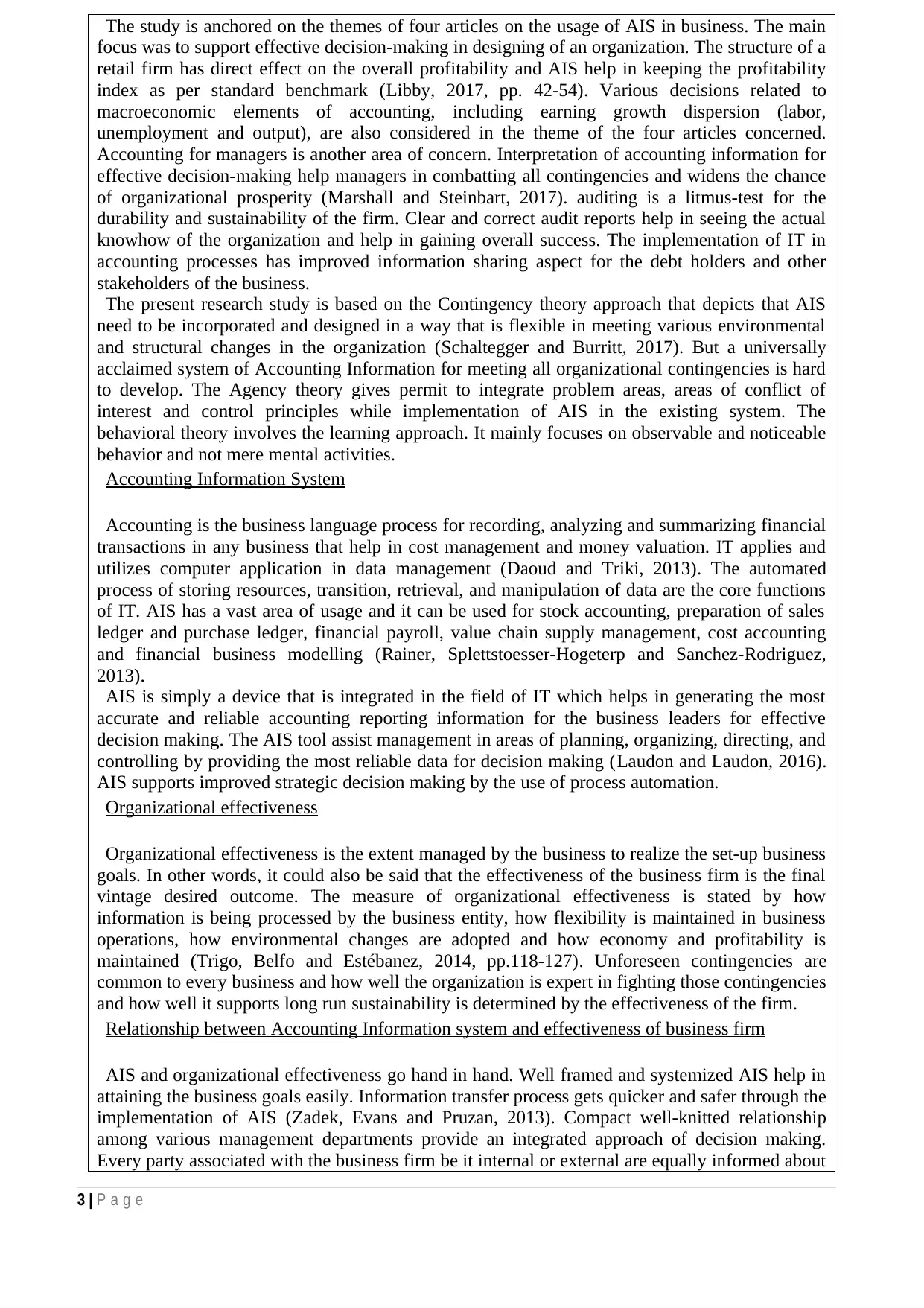
The study is anchored on the themes of four articles on the usage of AIS in business. The main
focus was to support effective decision-making in designing of an organization. The structure of a
retail firm has direct effect on the overall profitability and AIS help in keeping the profitability
index as per standard benchmark (Libby, 2017, pp. 42-54). Various decisions related to
macroeconomic elements of accounting, including earning growth dispersion (labor,
unemployment and output), are also considered in the theme of the four articles concerned.
Accounting for managers is another area of concern. Interpretation of accounting information for
effective decision-making help managers in combatting all contingencies and widens the chance
of organizational prosperity (Marshall and Steinbart, 2017). auditing is a litmus-test for the
durability and sustainability of the firm. Clear and correct audit reports help in seeing the actual
knowhow of the organization and help in gaining overall success. The implementation of IT in
accounting processes has improved information sharing aspect for the debt holders and other
stakeholders of the business.
The present research study is based on the Contingency theory approach that depicts that AIS
need to be incorporated and designed in a way that is flexible in meeting various environmental
and structural changes in the organization (Schaltegger and Burritt, 2017). But a universally
acclaimed system of Accounting Information for meeting all organizational contingencies is hard
to develop. The Agency theory gives permit to integrate problem areas, areas of conflict of
interest and control principles while implementation of AIS in the existing system. The
behavioral theory involves the learning approach. It mainly focuses on observable and noticeable
behavior and not mere mental activities.
Accounting Information System
Accounting is the business language process for recording, analyzing and summarizing financial
transactions in any business that help in cost management and money valuation. IT applies and
utilizes computer application in data management (Daoud and Triki, 2013). The automated
process of storing resources, transition, retrieval, and manipulation of data are the core functions
of IT. AIS has a vast area of usage and it can be used for stock accounting, preparation of sales
ledger and purchase ledger, financial payroll, value chain supply management, cost accounting
and financial business modelling (Rainer, Splettstoesser-Hogeterp and Sanchez-Rodriguez,
2013).
AIS is simply a device that is integrated in the field of IT which helps in generating the most
accurate and reliable accounting reporting information for the business leaders for effective
decision making. The AIS tool assist management in areas of planning, organizing, directing, and
controlling by providing the most reliable data for decision making (Laudon and Laudon, 2016).
AIS supports improved strategic decision making by the use of process automation.
Organizational effectiveness
Organizational effectiveness is the extent managed by the business to realize the set-up business
goals. In other words, it could also be said that the effectiveness of the business firm is the final
vintage desired outcome. The measure of organizational effectiveness is stated by how
information is being processed by the business entity, how flexibility is maintained in business
operations, how environmental changes are adopted and how economy and profitability is
maintained (Trigo, Belfo and Estébanez, 2014, pp.118-127). Unforeseen contingencies are
common to every business and how well the organization is expert in fighting those contingencies
and how well it supports long run sustainability is determined by the effectiveness of the firm.
Relationship between Accounting Information system and effectiveness of business firm
AIS and organizational effectiveness go hand in hand. Well framed and systemized AIS help in
attaining the business goals easily. Information transfer process gets quicker and safer through the
implementation of AIS (Zadek, Evans and Pruzan, 2013). Compact well-knitted relationship
among various management departments provide an integrated approach of decision making.
Every party associated with the business firm be it internal or external are equally informed about
3 | P a g e
focus was to support effective decision-making in designing of an organization. The structure of a
retail firm has direct effect on the overall profitability and AIS help in keeping the profitability
index as per standard benchmark (Libby, 2017, pp. 42-54). Various decisions related to
macroeconomic elements of accounting, including earning growth dispersion (labor,
unemployment and output), are also considered in the theme of the four articles concerned.
Accounting for managers is another area of concern. Interpretation of accounting information for
effective decision-making help managers in combatting all contingencies and widens the chance
of organizational prosperity (Marshall and Steinbart, 2017). auditing is a litmus-test for the
durability and sustainability of the firm. Clear and correct audit reports help in seeing the actual
knowhow of the organization and help in gaining overall success. The implementation of IT in
accounting processes has improved information sharing aspect for the debt holders and other
stakeholders of the business.
The present research study is based on the Contingency theory approach that depicts that AIS
need to be incorporated and designed in a way that is flexible in meeting various environmental
and structural changes in the organization (Schaltegger and Burritt, 2017). But a universally
acclaimed system of Accounting Information for meeting all organizational contingencies is hard
to develop. The Agency theory gives permit to integrate problem areas, areas of conflict of
interest and control principles while implementation of AIS in the existing system. The
behavioral theory involves the learning approach. It mainly focuses on observable and noticeable
behavior and not mere mental activities.
Accounting Information System
Accounting is the business language process for recording, analyzing and summarizing financial
transactions in any business that help in cost management and money valuation. IT applies and
utilizes computer application in data management (Daoud and Triki, 2013). The automated
process of storing resources, transition, retrieval, and manipulation of data are the core functions
of IT. AIS has a vast area of usage and it can be used for stock accounting, preparation of sales
ledger and purchase ledger, financial payroll, value chain supply management, cost accounting
and financial business modelling (Rainer, Splettstoesser-Hogeterp and Sanchez-Rodriguez,
2013).
AIS is simply a device that is integrated in the field of IT which helps in generating the most
accurate and reliable accounting reporting information for the business leaders for effective
decision making. The AIS tool assist management in areas of planning, organizing, directing, and
controlling by providing the most reliable data for decision making (Laudon and Laudon, 2016).
AIS supports improved strategic decision making by the use of process automation.
Organizational effectiveness
Organizational effectiveness is the extent managed by the business to realize the set-up business
goals. In other words, it could also be said that the effectiveness of the business firm is the final
vintage desired outcome. The measure of organizational effectiveness is stated by how
information is being processed by the business entity, how flexibility is maintained in business
operations, how environmental changes are adopted and how economy and profitability is
maintained (Trigo, Belfo and Estébanez, 2014, pp.118-127). Unforeseen contingencies are
common to every business and how well the organization is expert in fighting those contingencies
and how well it supports long run sustainability is determined by the effectiveness of the firm.
Relationship between Accounting Information system and effectiveness of business firm
AIS and organizational effectiveness go hand in hand. Well framed and systemized AIS help in
attaining the business goals easily. Information transfer process gets quicker and safer through the
implementation of AIS (Zadek, Evans and Pruzan, 2013). Compact well-knitted relationship
among various management departments provide an integrated approach of decision making.
Every party associated with the business firm be it internal or external are equally informed about
3 | P a g e
⊘ This is a preview!⊘
Do you want full access?
Subscribe today to unlock all pages.

Trusted by 1+ million students worldwide
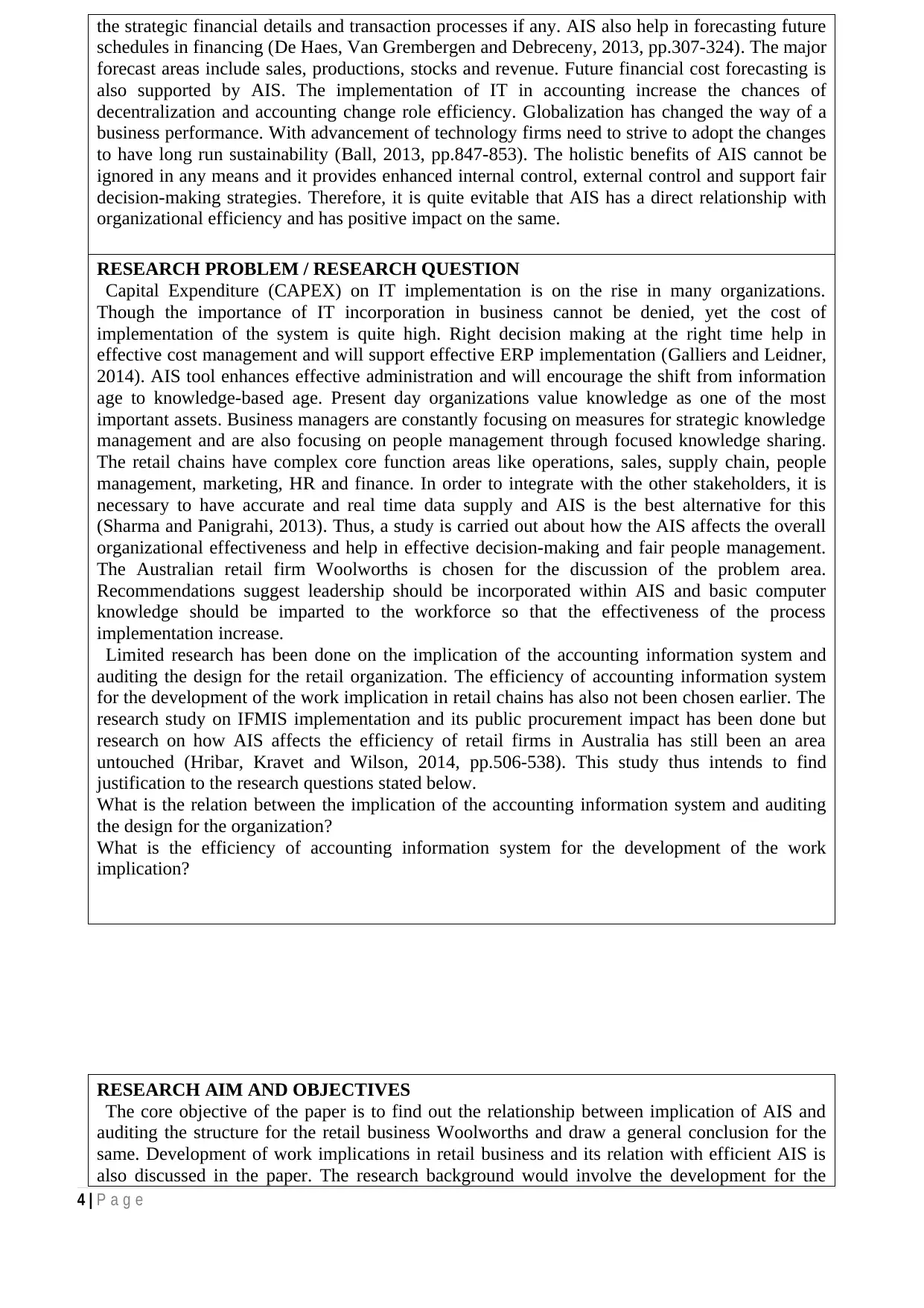
the strategic financial details and transaction processes if any. AIS also help in forecasting future
schedules in financing (De Haes, Van Grembergen and Debreceny, 2013, pp.307-324). The major
forecast areas include sales, productions, stocks and revenue. Future financial cost forecasting is
also supported by AIS. The implementation of IT in accounting increase the chances of
decentralization and accounting change role efficiency. Globalization has changed the way of a
business performance. With advancement of technology firms need to strive to adopt the changes
to have long run sustainability (Ball, 2013, pp.847-853). The holistic benefits of AIS cannot be
ignored in any means and it provides enhanced internal control, external control and support fair
decision-making strategies. Therefore, it is quite evitable that AIS has a direct relationship with
organizational efficiency and has positive impact on the same.
RESEARCH PROBLEM / RESEARCH QUESTION
Capital Expenditure (CAPEX) on IT implementation is on the rise in many organizations.
Though the importance of IT incorporation in business cannot be denied, yet the cost of
implementation of the system is quite high. Right decision making at the right time help in
effective cost management and will support effective ERP implementation (Galliers and Leidner,
2014). AIS tool enhances effective administration and will encourage the shift from information
age to knowledge-based age. Present day organizations value knowledge as one of the most
important assets. Business managers are constantly focusing on measures for strategic knowledge
management and are also focusing on people management through focused knowledge sharing.
The retail chains have complex core function areas like operations, sales, supply chain, people
management, marketing, HR and finance. In order to integrate with the other stakeholders, it is
necessary to have accurate and real time data supply and AIS is the best alternative for this
(Sharma and Panigrahi, 2013). Thus, a study is carried out about how the AIS affects the overall
organizational effectiveness and help in effective decision-making and fair people management.
The Australian retail firm Woolworths is chosen for the discussion of the problem area.
Recommendations suggest leadership should be incorporated within AIS and basic computer
knowledge should be imparted to the workforce so that the effectiveness of the process
implementation increase.
Limited research has been done on the implication of the accounting information system and
auditing the design for the retail organization. The efficiency of accounting information system
for the development of the work implication in retail chains has also not been chosen earlier. The
research study on IFMIS implementation and its public procurement impact has been done but
research on how AIS affects the efficiency of retail firms in Australia has still been an area
untouched (Hribar, Kravet and Wilson, 2014, pp.506-538). This study thus intends to find
justification to the research questions stated below.
What is the relation between the implication of the accounting information system and auditing
the design for the organization?
What is the efficiency of accounting information system for the development of the work
implication?
RESEARCH AIM AND OBJECTIVES
The core objective of the paper is to find out the relationship between implication of AIS and
auditing the structure for the retail business Woolworths and draw a general conclusion for the
same. Development of work implications in retail business and its relation with efficient AIS is
also discussed in the paper. The research background would involve the development for the
4 | P a g e
schedules in financing (De Haes, Van Grembergen and Debreceny, 2013, pp.307-324). The major
forecast areas include sales, productions, stocks and revenue. Future financial cost forecasting is
also supported by AIS. The implementation of IT in accounting increase the chances of
decentralization and accounting change role efficiency. Globalization has changed the way of a
business performance. With advancement of technology firms need to strive to adopt the changes
to have long run sustainability (Ball, 2013, pp.847-853). The holistic benefits of AIS cannot be
ignored in any means and it provides enhanced internal control, external control and support fair
decision-making strategies. Therefore, it is quite evitable that AIS has a direct relationship with
organizational efficiency and has positive impact on the same.
RESEARCH PROBLEM / RESEARCH QUESTION
Capital Expenditure (CAPEX) on IT implementation is on the rise in many organizations.
Though the importance of IT incorporation in business cannot be denied, yet the cost of
implementation of the system is quite high. Right decision making at the right time help in
effective cost management and will support effective ERP implementation (Galliers and Leidner,
2014). AIS tool enhances effective administration and will encourage the shift from information
age to knowledge-based age. Present day organizations value knowledge as one of the most
important assets. Business managers are constantly focusing on measures for strategic knowledge
management and are also focusing on people management through focused knowledge sharing.
The retail chains have complex core function areas like operations, sales, supply chain, people
management, marketing, HR and finance. In order to integrate with the other stakeholders, it is
necessary to have accurate and real time data supply and AIS is the best alternative for this
(Sharma and Panigrahi, 2013). Thus, a study is carried out about how the AIS affects the overall
organizational effectiveness and help in effective decision-making and fair people management.
The Australian retail firm Woolworths is chosen for the discussion of the problem area.
Recommendations suggest leadership should be incorporated within AIS and basic computer
knowledge should be imparted to the workforce so that the effectiveness of the process
implementation increase.
Limited research has been done on the implication of the accounting information system and
auditing the design for the retail organization. The efficiency of accounting information system
for the development of the work implication in retail chains has also not been chosen earlier. The
research study on IFMIS implementation and its public procurement impact has been done but
research on how AIS affects the efficiency of retail firms in Australia has still been an area
untouched (Hribar, Kravet and Wilson, 2014, pp.506-538). This study thus intends to find
justification to the research questions stated below.
What is the relation between the implication of the accounting information system and auditing
the design for the organization?
What is the efficiency of accounting information system for the development of the work
implication?
RESEARCH AIM AND OBJECTIVES
The core objective of the paper is to find out the relationship between implication of AIS and
auditing the structure for the retail business Woolworths and draw a general conclusion for the
same. Development of work implications in retail business and its relation with efficient AIS is
also discussed in the paper. The research background would involve the development for the
4 | P a g e
Paraphrase This Document
Need a fresh take? Get an instant paraphrase of this document with our AI Paraphraser
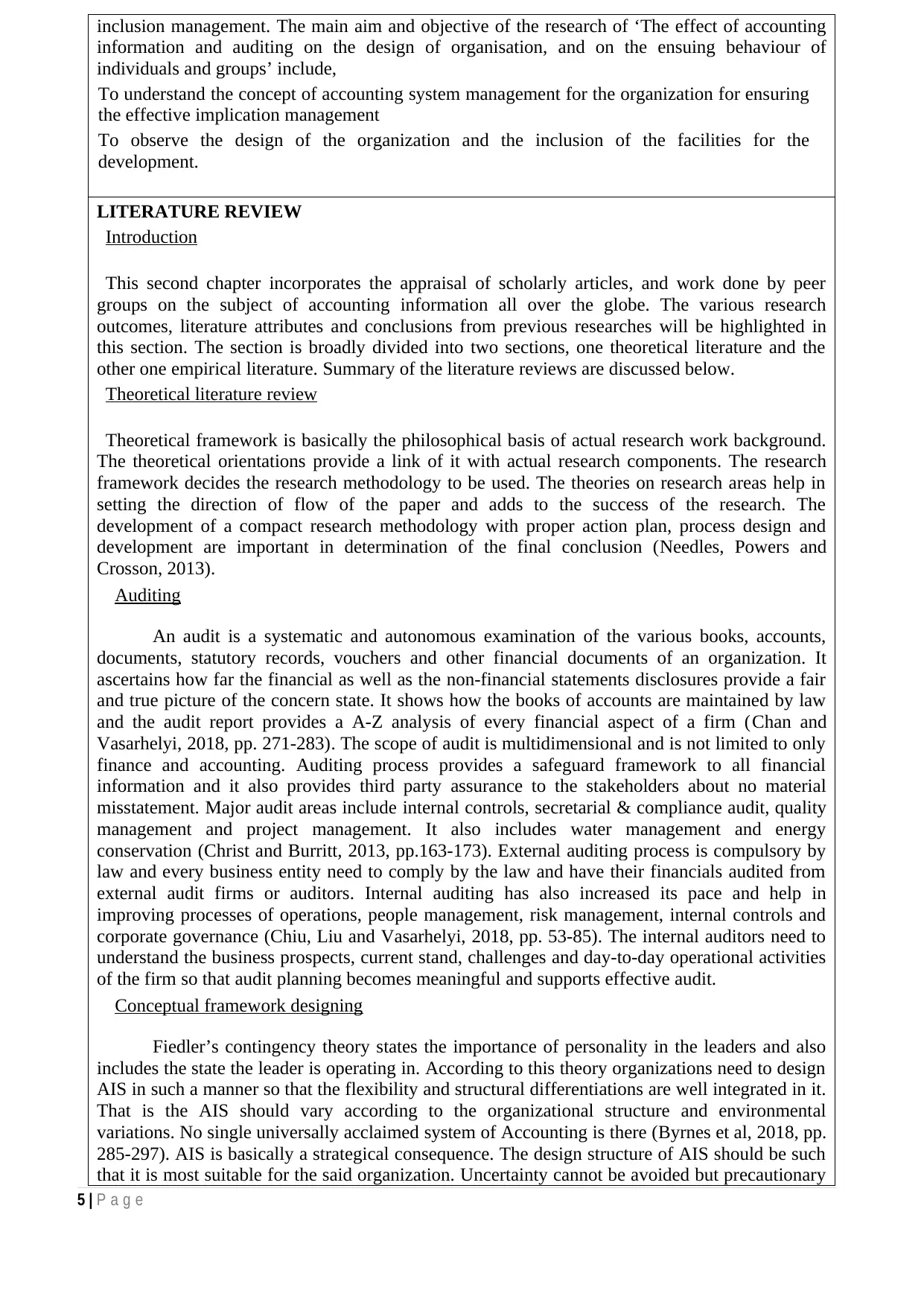
inclusion management. The main aim and objective of the research of ‘The effect of accounting
information and auditing on the design of organisation, and on the ensuing behaviour of
individuals and groups’ include,
To understand the concept of accounting system management for the organization for ensuring
the effective implication management
To observe the design of the organization and the inclusion of the facilities for the
development.
LITERATURE REVIEW
Introduction
This second chapter incorporates the appraisal of scholarly articles, and work done by peer
groups on the subject of accounting information all over the globe. The various research
outcomes, literature attributes and conclusions from previous researches will be highlighted in
this section. The section is broadly divided into two sections, one theoretical literature and the
other one empirical literature. Summary of the literature reviews are discussed below.
Theoretical literature review
Theoretical framework is basically the philosophical basis of actual research work background.
The theoretical orientations provide a link of it with actual research components. The research
framework decides the research methodology to be used. The theories on research areas help in
setting the direction of flow of the paper and adds to the success of the research. The
development of a compact research methodology with proper action plan, process design and
development are important in determination of the final conclusion (Needles, Powers and
Crosson, 2013).
Auditing
An audit is a systematic and autonomous examination of the various books, accounts,
documents, statutory records, vouchers and other financial documents of an organization. It
ascertains how far the financial as well as the non-financial statements disclosures provide a fair
and true picture of the concern state. It shows how the books of accounts are maintained by law
and the audit report provides a A-Z analysis of every financial aspect of a firm (Chan and
Vasarhelyi, 2018, pp. 271-283). The scope of audit is multidimensional and is not limited to only
finance and accounting. Auditing process provides a safeguard framework to all financial
information and it also provides third party assurance to the stakeholders about no material
misstatement. Major audit areas include internal controls, secretarial & compliance audit, quality
management and project management. It also includes water management and energy
conservation (Christ and Burritt, 2013, pp.163-173). External auditing process is compulsory by
law and every business entity need to comply by the law and have their financials audited from
external audit firms or auditors. Internal auditing has also increased its pace and help in
improving processes of operations, people management, risk management, internal controls and
corporate governance (Chiu, Liu and Vasarhelyi, 2018, pp. 53-85). The internal auditors need to
understand the business prospects, current stand, challenges and day-to-day operational activities
of the firm so that audit planning becomes meaningful and supports effective audit.
Conceptual framework designing
Fiedler’s contingency theory states the importance of personality in the leaders and also
includes the state the leader is operating in. According to this theory organizations need to design
AIS in such a manner so that the flexibility and structural differentiations are well integrated in it.
That is the AIS should vary according to the organizational structure and environmental
variations. No single universally acclaimed system of Accounting is there (Byrnes et al, 2018, pp.
285-297). AIS is basically a strategical consequence. The design structure of AIS should be such
that it is most suitable for the said organization. Uncertainty cannot be avoided but precautionary
5 | P a g e
information and auditing on the design of organisation, and on the ensuing behaviour of
individuals and groups’ include,
To understand the concept of accounting system management for the organization for ensuring
the effective implication management
To observe the design of the organization and the inclusion of the facilities for the
development.
LITERATURE REVIEW
Introduction
This second chapter incorporates the appraisal of scholarly articles, and work done by peer
groups on the subject of accounting information all over the globe. The various research
outcomes, literature attributes and conclusions from previous researches will be highlighted in
this section. The section is broadly divided into two sections, one theoretical literature and the
other one empirical literature. Summary of the literature reviews are discussed below.
Theoretical literature review
Theoretical framework is basically the philosophical basis of actual research work background.
The theoretical orientations provide a link of it with actual research components. The research
framework decides the research methodology to be used. The theories on research areas help in
setting the direction of flow of the paper and adds to the success of the research. The
development of a compact research methodology with proper action plan, process design and
development are important in determination of the final conclusion (Needles, Powers and
Crosson, 2013).
Auditing
An audit is a systematic and autonomous examination of the various books, accounts,
documents, statutory records, vouchers and other financial documents of an organization. It
ascertains how far the financial as well as the non-financial statements disclosures provide a fair
and true picture of the concern state. It shows how the books of accounts are maintained by law
and the audit report provides a A-Z analysis of every financial aspect of a firm (Chan and
Vasarhelyi, 2018, pp. 271-283). The scope of audit is multidimensional and is not limited to only
finance and accounting. Auditing process provides a safeguard framework to all financial
information and it also provides third party assurance to the stakeholders about no material
misstatement. Major audit areas include internal controls, secretarial & compliance audit, quality
management and project management. It also includes water management and energy
conservation (Christ and Burritt, 2013, pp.163-173). External auditing process is compulsory by
law and every business entity need to comply by the law and have their financials audited from
external audit firms or auditors. Internal auditing has also increased its pace and help in
improving processes of operations, people management, risk management, internal controls and
corporate governance (Chiu, Liu and Vasarhelyi, 2018, pp. 53-85). The internal auditors need to
understand the business prospects, current stand, challenges and day-to-day operational activities
of the firm so that audit planning becomes meaningful and supports effective audit.
Conceptual framework designing
Fiedler’s contingency theory states the importance of personality in the leaders and also
includes the state the leader is operating in. According to this theory organizations need to design
AIS in such a manner so that the flexibility and structural differentiations are well integrated in it.
That is the AIS should vary according to the organizational structure and environmental
variations. No single universally acclaimed system of Accounting is there (Byrnes et al, 2018, pp.
285-297). AIS is basically a strategical consequence. The design structure of AIS should be such
that it is most suitable for the said organization. Uncertainty cannot be avoided but precautionary
5 | P a g e
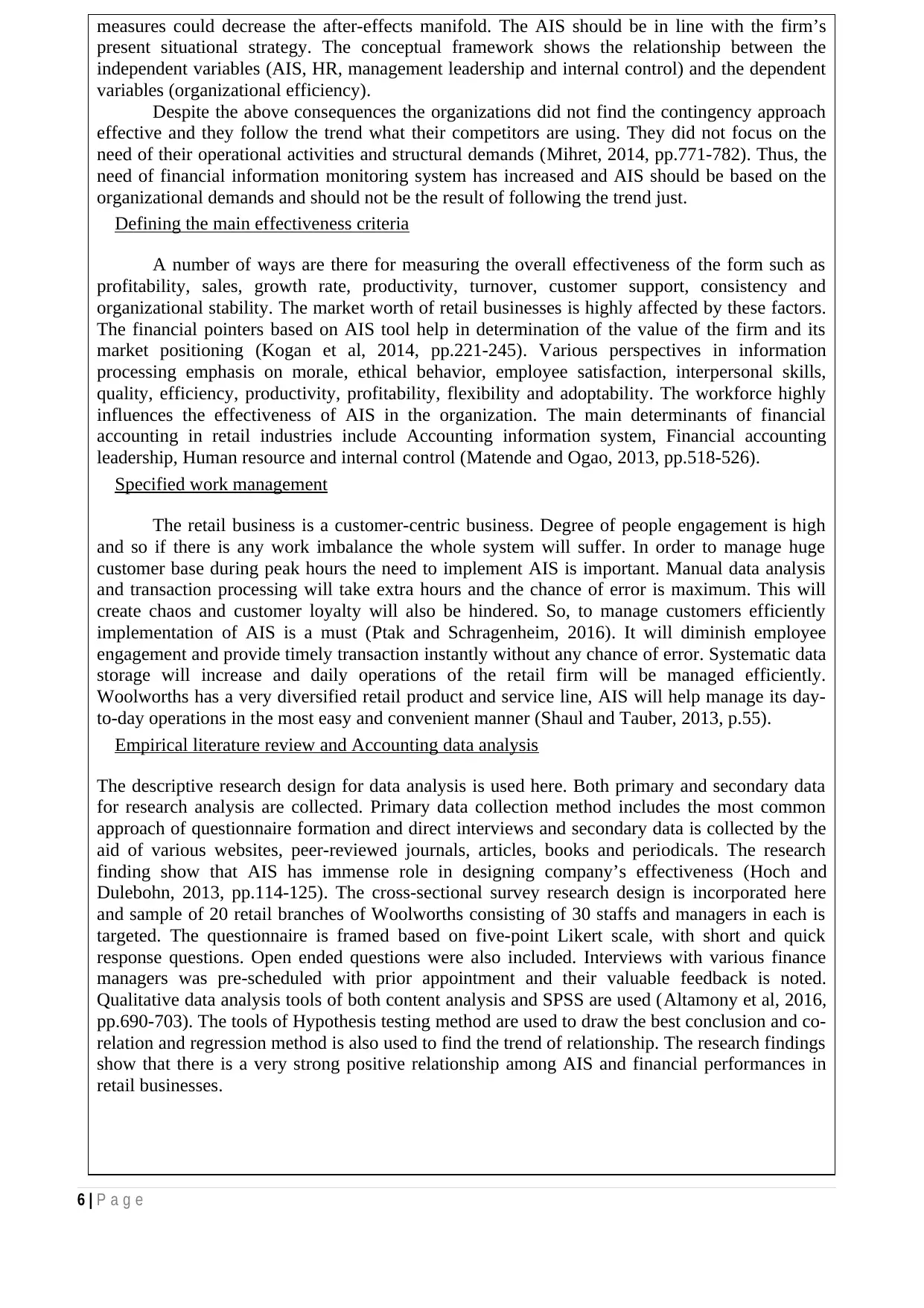
measures could decrease the after-effects manifold. The AIS should be in line with the firm’s
present situational strategy. The conceptual framework shows the relationship between the
independent variables (AIS, HR, management leadership and internal control) and the dependent
variables (organizational efficiency).
Despite the above consequences the organizations did not find the contingency approach
effective and they follow the trend what their competitors are using. They did not focus on the
need of their operational activities and structural demands (Mihret, 2014, pp.771-782). Thus, the
need of financial information monitoring system has increased and AIS should be based on the
organizational demands and should not be the result of following the trend just.
Defining the main effectiveness criteria
A number of ways are there for measuring the overall effectiveness of the form such as
profitability, sales, growth rate, productivity, turnover, customer support, consistency and
organizational stability. The market worth of retail businesses is highly affected by these factors.
The financial pointers based on AIS tool help in determination of the value of the firm and its
market positioning (Kogan et al, 2014, pp.221-245). Various perspectives in information
processing emphasis on morale, ethical behavior, employee satisfaction, interpersonal skills,
quality, efficiency, productivity, profitability, flexibility and adoptability. The workforce highly
influences the effectiveness of AIS in the organization. The main determinants of financial
accounting in retail industries include Accounting information system, Financial accounting
leadership, Human resource and internal control (Matende and Ogao, 2013, pp.518-526).
Specified work management
The retail business is a customer-centric business. Degree of people engagement is high
and so if there is any work imbalance the whole system will suffer. In order to manage huge
customer base during peak hours the need to implement AIS is important. Manual data analysis
and transaction processing will take extra hours and the chance of error is maximum. This will
create chaos and customer loyalty will also be hindered. So, to manage customers efficiently
implementation of AIS is a must (Ptak and Schragenheim, 2016). It will diminish employee
engagement and provide timely transaction instantly without any chance of error. Systematic data
storage will increase and daily operations of the retail firm will be managed efficiently.
Woolworths has a very diversified retail product and service line, AIS will help manage its day-
to-day operations in the most easy and convenient manner (Shaul and Tauber, 2013, p.55).
Empirical literature review and Accounting data analysis
The descriptive research design for data analysis is used here. Both primary and secondary data
for research analysis are collected. Primary data collection method includes the most common
approach of questionnaire formation and direct interviews and secondary data is collected by the
aid of various websites, peer-reviewed journals, articles, books and periodicals. The research
finding show that AIS has immense role in designing company’s effectiveness (Hoch and
Dulebohn, 2013, pp.114-125). The cross-sectional survey research design is incorporated here
and sample of 20 retail branches of Woolworths consisting of 30 staffs and managers in each is
targeted. The questionnaire is framed based on five-point Likert scale, with short and quick
response questions. Open ended questions were also included. Interviews with various finance
managers was pre-scheduled with prior appointment and their valuable feedback is noted.
Qualitative data analysis tools of both content analysis and SPSS are used (Altamony et al, 2016,
pp.690-703). The tools of Hypothesis testing method are used to draw the best conclusion and co-
relation and regression method is also used to find the trend of relationship. The research findings
show that there is a very strong positive relationship among AIS and financial performances in
retail businesses.
6 | P a g e
present situational strategy. The conceptual framework shows the relationship between the
independent variables (AIS, HR, management leadership and internal control) and the dependent
variables (organizational efficiency).
Despite the above consequences the organizations did not find the contingency approach
effective and they follow the trend what their competitors are using. They did not focus on the
need of their operational activities and structural demands (Mihret, 2014, pp.771-782). Thus, the
need of financial information monitoring system has increased and AIS should be based on the
organizational demands and should not be the result of following the trend just.
Defining the main effectiveness criteria
A number of ways are there for measuring the overall effectiveness of the form such as
profitability, sales, growth rate, productivity, turnover, customer support, consistency and
organizational stability. The market worth of retail businesses is highly affected by these factors.
The financial pointers based on AIS tool help in determination of the value of the firm and its
market positioning (Kogan et al, 2014, pp.221-245). Various perspectives in information
processing emphasis on morale, ethical behavior, employee satisfaction, interpersonal skills,
quality, efficiency, productivity, profitability, flexibility and adoptability. The workforce highly
influences the effectiveness of AIS in the organization. The main determinants of financial
accounting in retail industries include Accounting information system, Financial accounting
leadership, Human resource and internal control (Matende and Ogao, 2013, pp.518-526).
Specified work management
The retail business is a customer-centric business. Degree of people engagement is high
and so if there is any work imbalance the whole system will suffer. In order to manage huge
customer base during peak hours the need to implement AIS is important. Manual data analysis
and transaction processing will take extra hours and the chance of error is maximum. This will
create chaos and customer loyalty will also be hindered. So, to manage customers efficiently
implementation of AIS is a must (Ptak and Schragenheim, 2016). It will diminish employee
engagement and provide timely transaction instantly without any chance of error. Systematic data
storage will increase and daily operations of the retail firm will be managed efficiently.
Woolworths has a very diversified retail product and service line, AIS will help manage its day-
to-day operations in the most easy and convenient manner (Shaul and Tauber, 2013, p.55).
Empirical literature review and Accounting data analysis
The descriptive research design for data analysis is used here. Both primary and secondary data
for research analysis are collected. Primary data collection method includes the most common
approach of questionnaire formation and direct interviews and secondary data is collected by the
aid of various websites, peer-reviewed journals, articles, books and periodicals. The research
finding show that AIS has immense role in designing company’s effectiveness (Hoch and
Dulebohn, 2013, pp.114-125). The cross-sectional survey research design is incorporated here
and sample of 20 retail branches of Woolworths consisting of 30 staffs and managers in each is
targeted. The questionnaire is framed based on five-point Likert scale, with short and quick
response questions. Open ended questions were also included. Interviews with various finance
managers was pre-scheduled with prior appointment and their valuable feedback is noted.
Qualitative data analysis tools of both content analysis and SPSS are used (Altamony et al, 2016,
pp.690-703). The tools of Hypothesis testing method are used to draw the best conclusion and co-
relation and regression method is also used to find the trend of relationship. The research findings
show that there is a very strong positive relationship among AIS and financial performances in
retail businesses.
6 | P a g e
⊘ This is a preview!⊘
Do you want full access?
Subscribe today to unlock all pages.

Trusted by 1+ million students worldwide
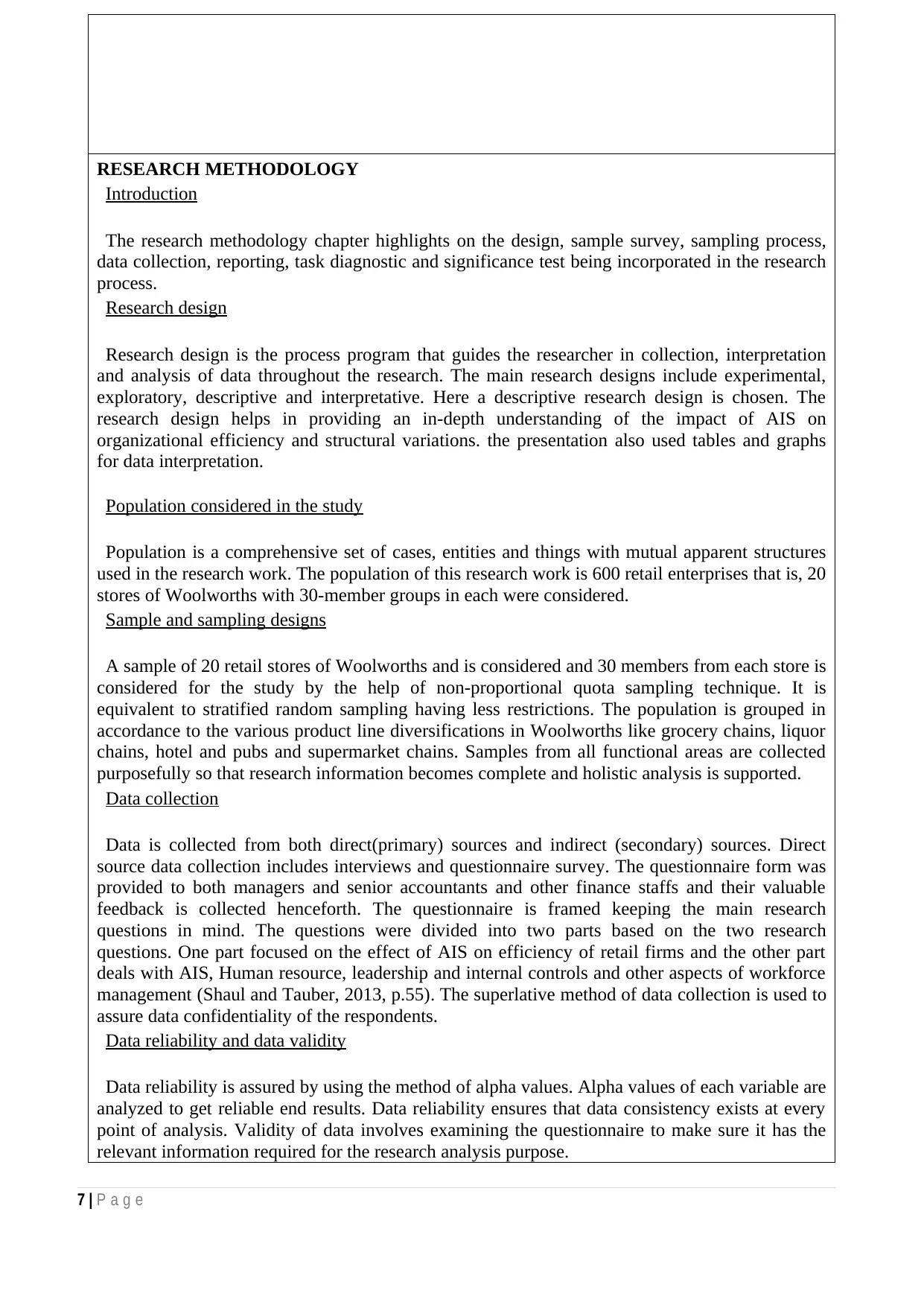
RESEARCH METHODOLOGY
Introduction
The research methodology chapter highlights on the design, sample survey, sampling process,
data collection, reporting, task diagnostic and significance test being incorporated in the research
process.
Research design
Research design is the process program that guides the researcher in collection, interpretation
and analysis of data throughout the research. The main research designs include experimental,
exploratory, descriptive and interpretative. Here a descriptive research design is chosen. The
research design helps in providing an in-depth understanding of the impact of AIS on
organizational efficiency and structural variations. the presentation also used tables and graphs
for data interpretation.
Population considered in the study
Population is a comprehensive set of cases, entities and things with mutual apparent structures
used in the research work. The population of this research work is 600 retail enterprises that is, 20
stores of Woolworths with 30-member groups in each were considered.
Sample and sampling designs
A sample of 20 retail stores of Woolworths and is considered and 30 members from each store is
considered for the study by the help of non-proportional quota sampling technique. It is
equivalent to stratified random sampling having less restrictions. The population is grouped in
accordance to the various product line diversifications in Woolworths like grocery chains, liquor
chains, hotel and pubs and supermarket chains. Samples from all functional areas are collected
purposefully so that research information becomes complete and holistic analysis is supported.
Data collection
Data is collected from both direct(primary) sources and indirect (secondary) sources. Direct
source data collection includes interviews and questionnaire survey. The questionnaire form was
provided to both managers and senior accountants and other finance staffs and their valuable
feedback is collected henceforth. The questionnaire is framed keeping the main research
questions in mind. The questions were divided into two parts based on the two research
questions. One part focused on the effect of AIS on efficiency of retail firms and the other part
deals with AIS, Human resource, leadership and internal controls and other aspects of workforce
management (Shaul and Tauber, 2013, p.55). The superlative method of data collection is used to
assure data confidentiality of the respondents.
Data reliability and data validity
Data reliability is assured by using the method of alpha values. Alpha values of each variable are
analyzed to get reliable end results. Data reliability ensures that data consistency exists at every
point of analysis. Validity of data involves examining the questionnaire to make sure it has the
relevant information required for the research analysis purpose.
7 | P a g e
Introduction
The research methodology chapter highlights on the design, sample survey, sampling process,
data collection, reporting, task diagnostic and significance test being incorporated in the research
process.
Research design
Research design is the process program that guides the researcher in collection, interpretation
and analysis of data throughout the research. The main research designs include experimental,
exploratory, descriptive and interpretative. Here a descriptive research design is chosen. The
research design helps in providing an in-depth understanding of the impact of AIS on
organizational efficiency and structural variations. the presentation also used tables and graphs
for data interpretation.
Population considered in the study
Population is a comprehensive set of cases, entities and things with mutual apparent structures
used in the research work. The population of this research work is 600 retail enterprises that is, 20
stores of Woolworths with 30-member groups in each were considered.
Sample and sampling designs
A sample of 20 retail stores of Woolworths and is considered and 30 members from each store is
considered for the study by the help of non-proportional quota sampling technique. It is
equivalent to stratified random sampling having less restrictions. The population is grouped in
accordance to the various product line diversifications in Woolworths like grocery chains, liquor
chains, hotel and pubs and supermarket chains. Samples from all functional areas are collected
purposefully so that research information becomes complete and holistic analysis is supported.
Data collection
Data is collected from both direct(primary) sources and indirect (secondary) sources. Direct
source data collection includes interviews and questionnaire survey. The questionnaire form was
provided to both managers and senior accountants and other finance staffs and their valuable
feedback is collected henceforth. The questionnaire is framed keeping the main research
questions in mind. The questions were divided into two parts based on the two research
questions. One part focused on the effect of AIS on efficiency of retail firms and the other part
deals with AIS, Human resource, leadership and internal controls and other aspects of workforce
management (Shaul and Tauber, 2013, p.55). The superlative method of data collection is used to
assure data confidentiality of the respondents.
Data reliability and data validity
Data reliability is assured by using the method of alpha values. Alpha values of each variable are
analyzed to get reliable end results. Data reliability ensures that data consistency exists at every
point of analysis. Validity of data involves examining the questionnaire to make sure it has the
relevant information required for the research analysis purpose.
7 | P a g e
Paraphrase This Document
Need a fresh take? Get an instant paraphrase of this document with our AI Paraphraser
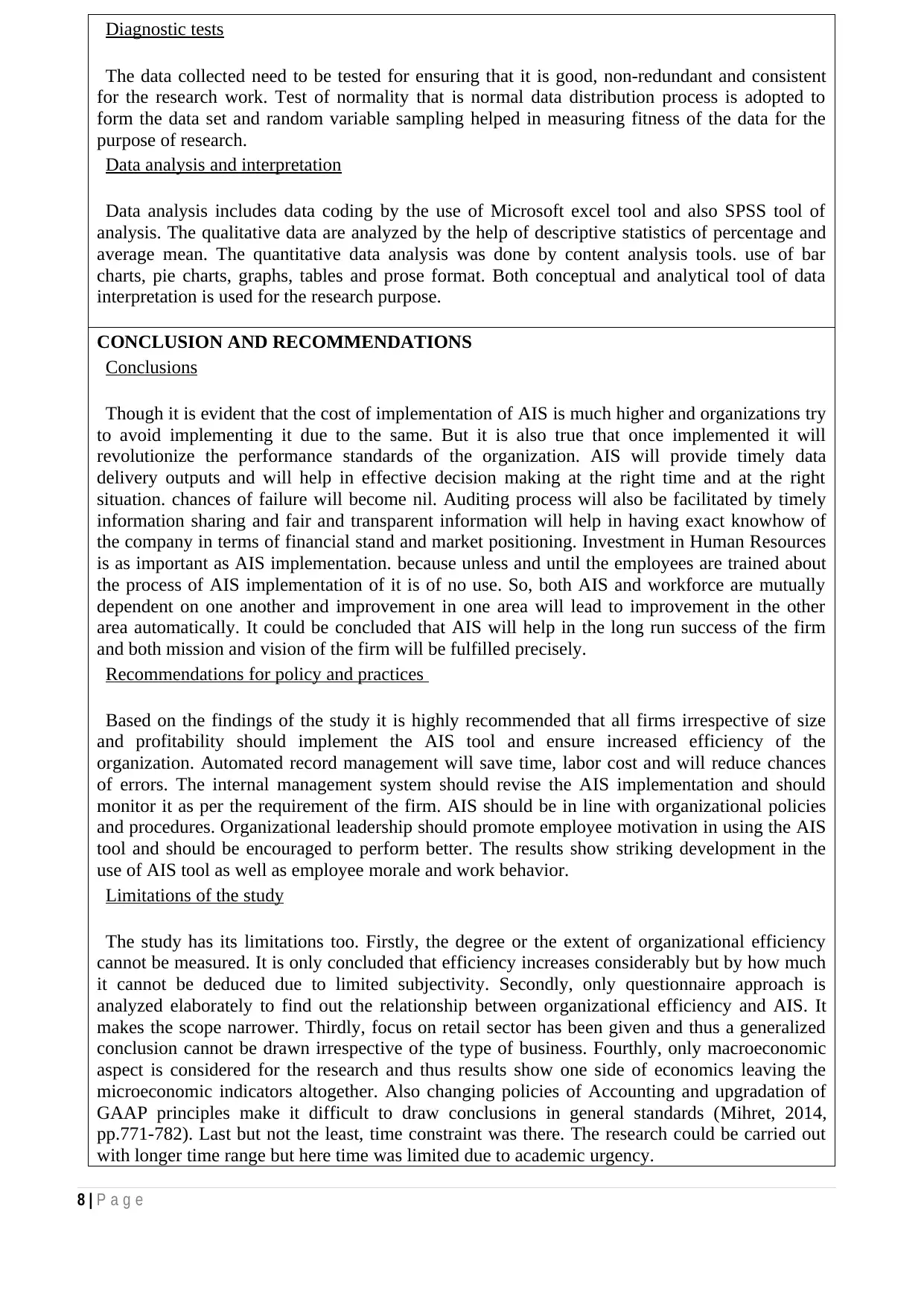
Diagnostic tests
The data collected need to be tested for ensuring that it is good, non-redundant and consistent
for the research work. Test of normality that is normal data distribution process is adopted to
form the data set and random variable sampling helped in measuring fitness of the data for the
purpose of research.
Data analysis and interpretation
Data analysis includes data coding by the use of Microsoft excel tool and also SPSS tool of
analysis. The qualitative data are analyzed by the help of descriptive statistics of percentage and
average mean. The quantitative data analysis was done by content analysis tools. use of bar
charts, pie charts, graphs, tables and prose format. Both conceptual and analytical tool of data
interpretation is used for the research purpose.
CONCLUSION AND RECOMMENDATIONS
Conclusions
Though it is evident that the cost of implementation of AIS is much higher and organizations try
to avoid implementing it due to the same. But it is also true that once implemented it will
revolutionize the performance standards of the organization. AIS will provide timely data
delivery outputs and will help in effective decision making at the right time and at the right
situation. chances of failure will become nil. Auditing process will also be facilitated by timely
information sharing and fair and transparent information will help in having exact knowhow of
the company in terms of financial stand and market positioning. Investment in Human Resources
is as important as AIS implementation. because unless and until the employees are trained about
the process of AIS implementation of it is of no use. So, both AIS and workforce are mutually
dependent on one another and improvement in one area will lead to improvement in the other
area automatically. It could be concluded that AIS will help in the long run success of the firm
and both mission and vision of the firm will be fulfilled precisely.
Recommendations for policy and practices
Based on the findings of the study it is highly recommended that all firms irrespective of size
and profitability should implement the AIS tool and ensure increased efficiency of the
organization. Automated record management will save time, labor cost and will reduce chances
of errors. The internal management system should revise the AIS implementation and should
monitor it as per the requirement of the firm. AIS should be in line with organizational policies
and procedures. Organizational leadership should promote employee motivation in using the AIS
tool and should be encouraged to perform better. The results show striking development in the
use of AIS tool as well as employee morale and work behavior.
Limitations of the study
The study has its limitations too. Firstly, the degree or the extent of organizational efficiency
cannot be measured. It is only concluded that efficiency increases considerably but by how much
it cannot be deduced due to limited subjectivity. Secondly, only questionnaire approach is
analyzed elaborately to find out the relationship between organizational efficiency and AIS. It
makes the scope narrower. Thirdly, focus on retail sector has been given and thus a generalized
conclusion cannot be drawn irrespective of the type of business. Fourthly, only macroeconomic
aspect is considered for the research and thus results show one side of economics leaving the
microeconomic indicators altogether. Also changing policies of Accounting and upgradation of
GAAP principles make it difficult to draw conclusions in general standards (Mihret, 2014,
pp.771-782). Last but not the least, time constraint was there. The research could be carried out
with longer time range but here time was limited due to academic urgency.
8 | P a g e
The data collected need to be tested for ensuring that it is good, non-redundant and consistent
for the research work. Test of normality that is normal data distribution process is adopted to
form the data set and random variable sampling helped in measuring fitness of the data for the
purpose of research.
Data analysis and interpretation
Data analysis includes data coding by the use of Microsoft excel tool and also SPSS tool of
analysis. The qualitative data are analyzed by the help of descriptive statistics of percentage and
average mean. The quantitative data analysis was done by content analysis tools. use of bar
charts, pie charts, graphs, tables and prose format. Both conceptual and analytical tool of data
interpretation is used for the research purpose.
CONCLUSION AND RECOMMENDATIONS
Conclusions
Though it is evident that the cost of implementation of AIS is much higher and organizations try
to avoid implementing it due to the same. But it is also true that once implemented it will
revolutionize the performance standards of the organization. AIS will provide timely data
delivery outputs and will help in effective decision making at the right time and at the right
situation. chances of failure will become nil. Auditing process will also be facilitated by timely
information sharing and fair and transparent information will help in having exact knowhow of
the company in terms of financial stand and market positioning. Investment in Human Resources
is as important as AIS implementation. because unless and until the employees are trained about
the process of AIS implementation of it is of no use. So, both AIS and workforce are mutually
dependent on one another and improvement in one area will lead to improvement in the other
area automatically. It could be concluded that AIS will help in the long run success of the firm
and both mission and vision of the firm will be fulfilled precisely.
Recommendations for policy and practices
Based on the findings of the study it is highly recommended that all firms irrespective of size
and profitability should implement the AIS tool and ensure increased efficiency of the
organization. Automated record management will save time, labor cost and will reduce chances
of errors. The internal management system should revise the AIS implementation and should
monitor it as per the requirement of the firm. AIS should be in line with organizational policies
and procedures. Organizational leadership should promote employee motivation in using the AIS
tool and should be encouraged to perform better. The results show striking development in the
use of AIS tool as well as employee morale and work behavior.
Limitations of the study
The study has its limitations too. Firstly, the degree or the extent of organizational efficiency
cannot be measured. It is only concluded that efficiency increases considerably but by how much
it cannot be deduced due to limited subjectivity. Secondly, only questionnaire approach is
analyzed elaborately to find out the relationship between organizational efficiency and AIS. It
makes the scope narrower. Thirdly, focus on retail sector has been given and thus a generalized
conclusion cannot be drawn irrespective of the type of business. Fourthly, only macroeconomic
aspect is considered for the research and thus results show one side of economics leaving the
microeconomic indicators altogether. Also changing policies of Accounting and upgradation of
GAAP principles make it difficult to draw conclusions in general standards (Mihret, 2014,
pp.771-782). Last but not the least, time constraint was there. The research could be carried out
with longer time range but here time was limited due to academic urgency.
8 | P a g e
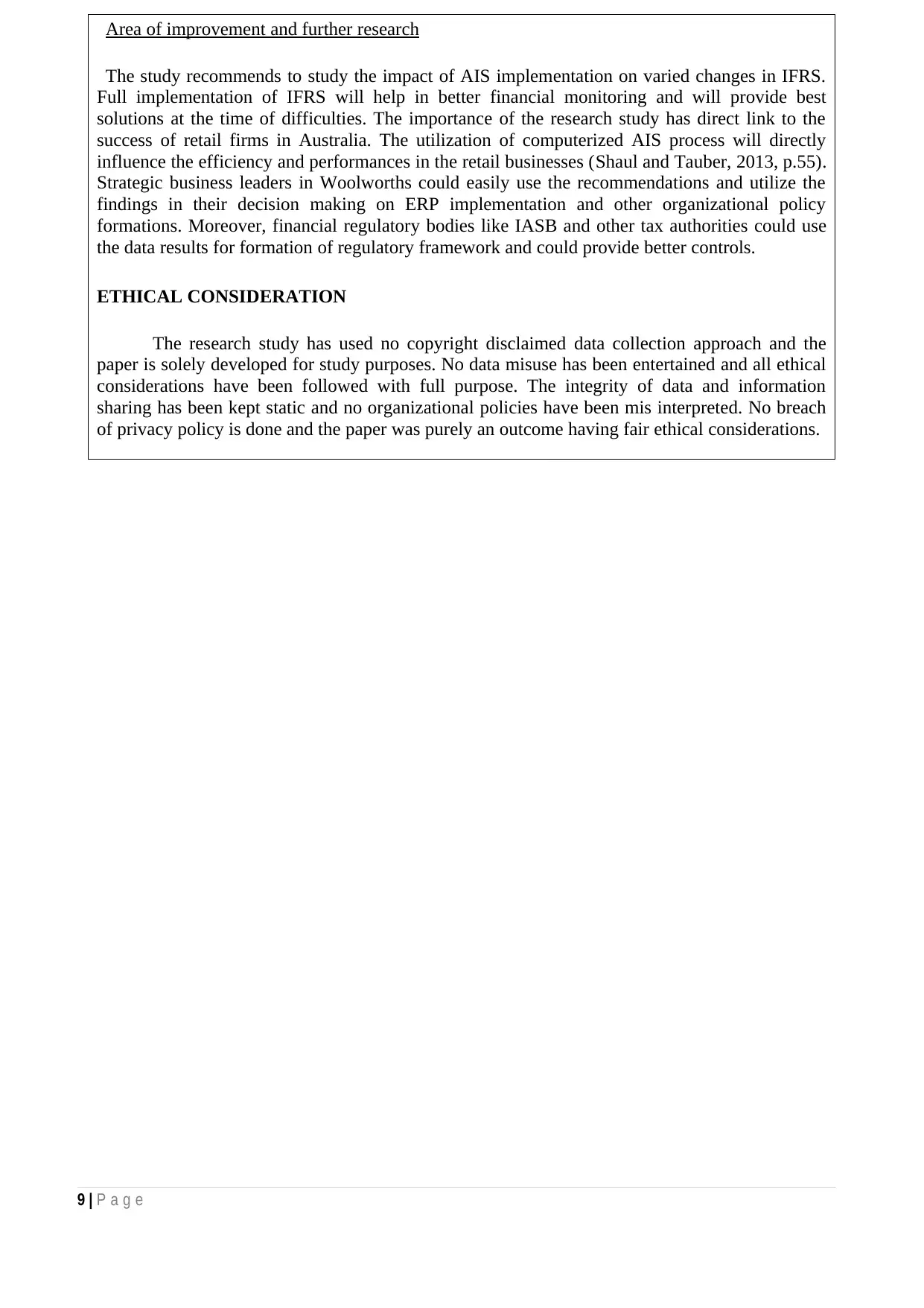
Area of improvement and further research
The study recommends to study the impact of AIS implementation on varied changes in IFRS.
Full implementation of IFRS will help in better financial monitoring and will provide best
solutions at the time of difficulties. The importance of the research study has direct link to the
success of retail firms in Australia. The utilization of computerized AIS process will directly
influence the efficiency and performances in the retail businesses (Shaul and Tauber, 2013, p.55).
Strategic business leaders in Woolworths could easily use the recommendations and utilize the
findings in their decision making on ERP implementation and other organizational policy
formations. Moreover, financial regulatory bodies like IASB and other tax authorities could use
the data results for formation of regulatory framework and could provide better controls.
ETHICAL CONSIDERATION
The research study has used no copyright disclaimed data collection approach and the
paper is solely developed for study purposes. No data misuse has been entertained and all ethical
considerations have been followed with full purpose. The integrity of data and information
sharing has been kept static and no organizational policies have been mis interpreted. No breach
of privacy policy is done and the paper was purely an outcome having fair ethical considerations.
9 | P a g e
The study recommends to study the impact of AIS implementation on varied changes in IFRS.
Full implementation of IFRS will help in better financial monitoring and will provide best
solutions at the time of difficulties. The importance of the research study has direct link to the
success of retail firms in Australia. The utilization of computerized AIS process will directly
influence the efficiency and performances in the retail businesses (Shaul and Tauber, 2013, p.55).
Strategic business leaders in Woolworths could easily use the recommendations and utilize the
findings in their decision making on ERP implementation and other organizational policy
formations. Moreover, financial regulatory bodies like IASB and other tax authorities could use
the data results for formation of regulatory framework and could provide better controls.
ETHICAL CONSIDERATION
The research study has used no copyright disclaimed data collection approach and the
paper is solely developed for study purposes. No data misuse has been entertained and all ethical
considerations have been followed with full purpose. The integrity of data and information
sharing has been kept static and no organizational policies have been mis interpreted. No breach
of privacy policy is done and the paper was purely an outcome having fair ethical considerations.
9 | P a g e
⊘ This is a preview!⊘
Do you want full access?
Subscribe today to unlock all pages.

Trusted by 1+ million students worldwide
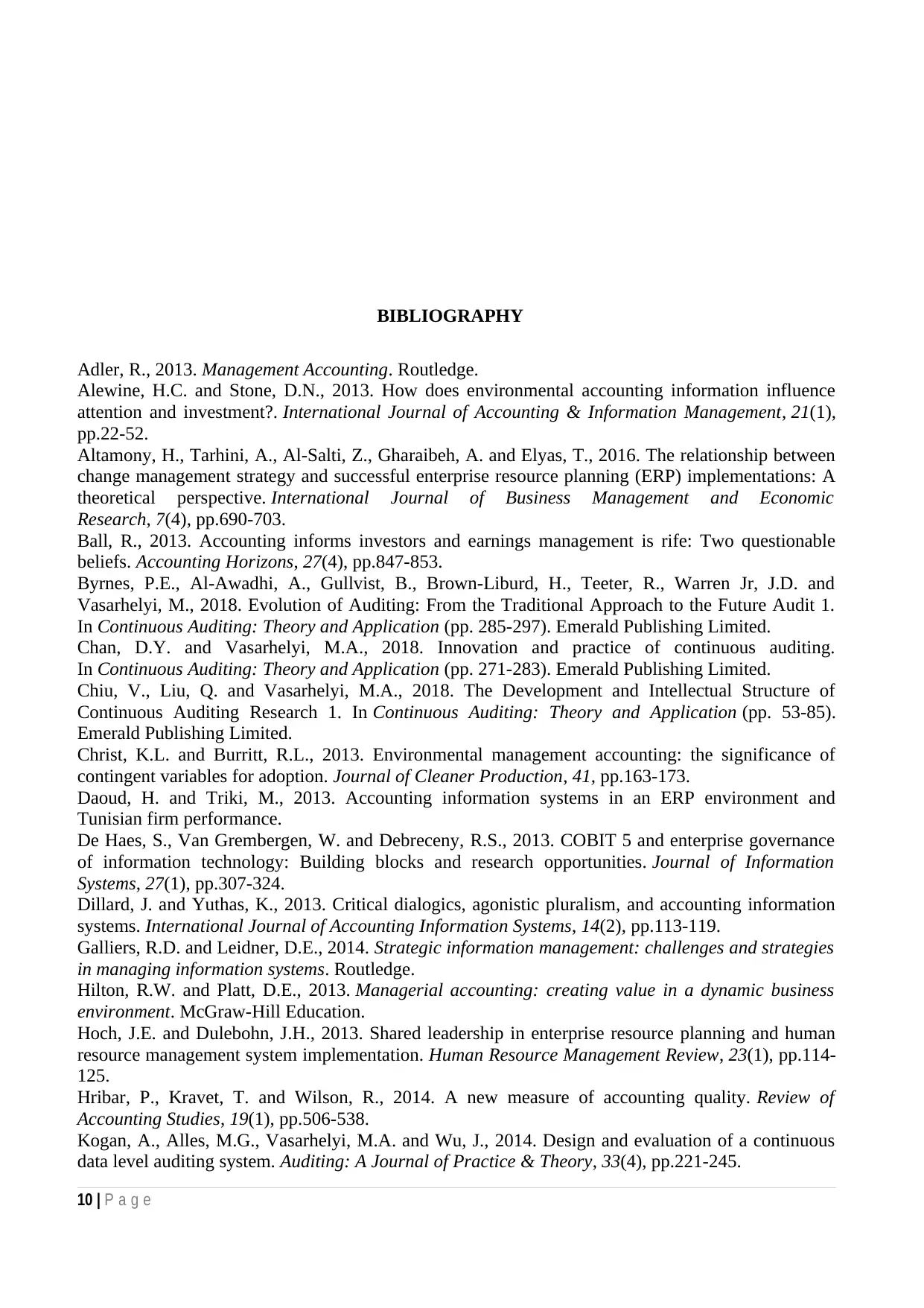
BIBLIOGRAPHY
Adler, R., 2013. Management Accounting. Routledge.
Alewine, H.C. and Stone, D.N., 2013. How does environmental accounting information influence
attention and investment?. International Journal of Accounting & Information Management, 21(1),
pp.22-52.
Altamony, H., Tarhini, A., Al-Salti, Z., Gharaibeh, A. and Elyas, T., 2016. The relationship between
change management strategy and successful enterprise resource planning (ERP) implementations: A
theoretical perspective. International Journal of Business Management and Economic
Research, 7(4), pp.690-703.
Ball, R., 2013. Accounting informs investors and earnings management is rife: Two questionable
beliefs. Accounting Horizons, 27(4), pp.847-853.
Byrnes, P.E., Al-Awadhi, A., Gullvist, B., Brown-Liburd, H., Teeter, R., Warren Jr, J.D. and
Vasarhelyi, M., 2018. Evolution of Auditing: From the Traditional Approach to the Future Audit 1.
In Continuous Auditing: Theory and Application (pp. 285-297). Emerald Publishing Limited.
Chan, D.Y. and Vasarhelyi, M.A., 2018. Innovation and practice of continuous auditing.
In Continuous Auditing: Theory and Application (pp. 271-283). Emerald Publishing Limited.
Chiu, V., Liu, Q. and Vasarhelyi, M.A., 2018. The Development and Intellectual Structure of
Continuous Auditing Research 1. In Continuous Auditing: Theory and Application (pp. 53-85).
Emerald Publishing Limited.
Christ, K.L. and Burritt, R.L., 2013. Environmental management accounting: the significance of
contingent variables for adoption. Journal of Cleaner Production, 41, pp.163-173.
Daoud, H. and Triki, M., 2013. Accounting information systems in an ERP environment and
Tunisian firm performance.
De Haes, S., Van Grembergen, W. and Debreceny, R.S., 2013. COBIT 5 and enterprise governance
of information technology: Building blocks and research opportunities. Journal of Information
Systems, 27(1), pp.307-324.
Dillard, J. and Yuthas, K., 2013. Critical dialogics, agonistic pluralism, and accounting information
systems. International Journal of Accounting Information Systems, 14(2), pp.113-119.
Galliers, R.D. and Leidner, D.E., 2014. Strategic information management: challenges and strategies
in managing information systems. Routledge.
Hilton, R.W. and Platt, D.E., 2013. Managerial accounting: creating value in a dynamic business
environment. McGraw-Hill Education.
Hoch, J.E. and Dulebohn, J.H., 2013. Shared leadership in enterprise resource planning and human
resource management system implementation. Human Resource Management Review, 23(1), pp.114-
125.
Hribar, P., Kravet, T. and Wilson, R., 2014. A new measure of accounting quality. Review of
Accounting Studies, 19(1), pp.506-538.
Kogan, A., Alles, M.G., Vasarhelyi, M.A. and Wu, J., 2014. Design and evaluation of a continuous
data level auditing system. Auditing: A Journal of Practice & Theory, 33(4), pp.221-245.
10 | P a g e
Adler, R., 2013. Management Accounting. Routledge.
Alewine, H.C. and Stone, D.N., 2013. How does environmental accounting information influence
attention and investment?. International Journal of Accounting & Information Management, 21(1),
pp.22-52.
Altamony, H., Tarhini, A., Al-Salti, Z., Gharaibeh, A. and Elyas, T., 2016. The relationship between
change management strategy and successful enterprise resource planning (ERP) implementations: A
theoretical perspective. International Journal of Business Management and Economic
Research, 7(4), pp.690-703.
Ball, R., 2013. Accounting informs investors and earnings management is rife: Two questionable
beliefs. Accounting Horizons, 27(4), pp.847-853.
Byrnes, P.E., Al-Awadhi, A., Gullvist, B., Brown-Liburd, H., Teeter, R., Warren Jr, J.D. and
Vasarhelyi, M., 2018. Evolution of Auditing: From the Traditional Approach to the Future Audit 1.
In Continuous Auditing: Theory and Application (pp. 285-297). Emerald Publishing Limited.
Chan, D.Y. and Vasarhelyi, M.A., 2018. Innovation and practice of continuous auditing.
In Continuous Auditing: Theory and Application (pp. 271-283). Emerald Publishing Limited.
Chiu, V., Liu, Q. and Vasarhelyi, M.A., 2018. The Development and Intellectual Structure of
Continuous Auditing Research 1. In Continuous Auditing: Theory and Application (pp. 53-85).
Emerald Publishing Limited.
Christ, K.L. and Burritt, R.L., 2013. Environmental management accounting: the significance of
contingent variables for adoption. Journal of Cleaner Production, 41, pp.163-173.
Daoud, H. and Triki, M., 2013. Accounting information systems in an ERP environment and
Tunisian firm performance.
De Haes, S., Van Grembergen, W. and Debreceny, R.S., 2013. COBIT 5 and enterprise governance
of information technology: Building blocks and research opportunities. Journal of Information
Systems, 27(1), pp.307-324.
Dillard, J. and Yuthas, K., 2013. Critical dialogics, agonistic pluralism, and accounting information
systems. International Journal of Accounting Information Systems, 14(2), pp.113-119.
Galliers, R.D. and Leidner, D.E., 2014. Strategic information management: challenges and strategies
in managing information systems. Routledge.
Hilton, R.W. and Platt, D.E., 2013. Managerial accounting: creating value in a dynamic business
environment. McGraw-Hill Education.
Hoch, J.E. and Dulebohn, J.H., 2013. Shared leadership in enterprise resource planning and human
resource management system implementation. Human Resource Management Review, 23(1), pp.114-
125.
Hribar, P., Kravet, T. and Wilson, R., 2014. A new measure of accounting quality. Review of
Accounting Studies, 19(1), pp.506-538.
Kogan, A., Alles, M.G., Vasarhelyi, M.A. and Wu, J., 2014. Design and evaluation of a continuous
data level auditing system. Auditing: A Journal of Practice & Theory, 33(4), pp.221-245.
10 | P a g e
Paraphrase This Document
Need a fresh take? Get an instant paraphrase of this document with our AI Paraphraser
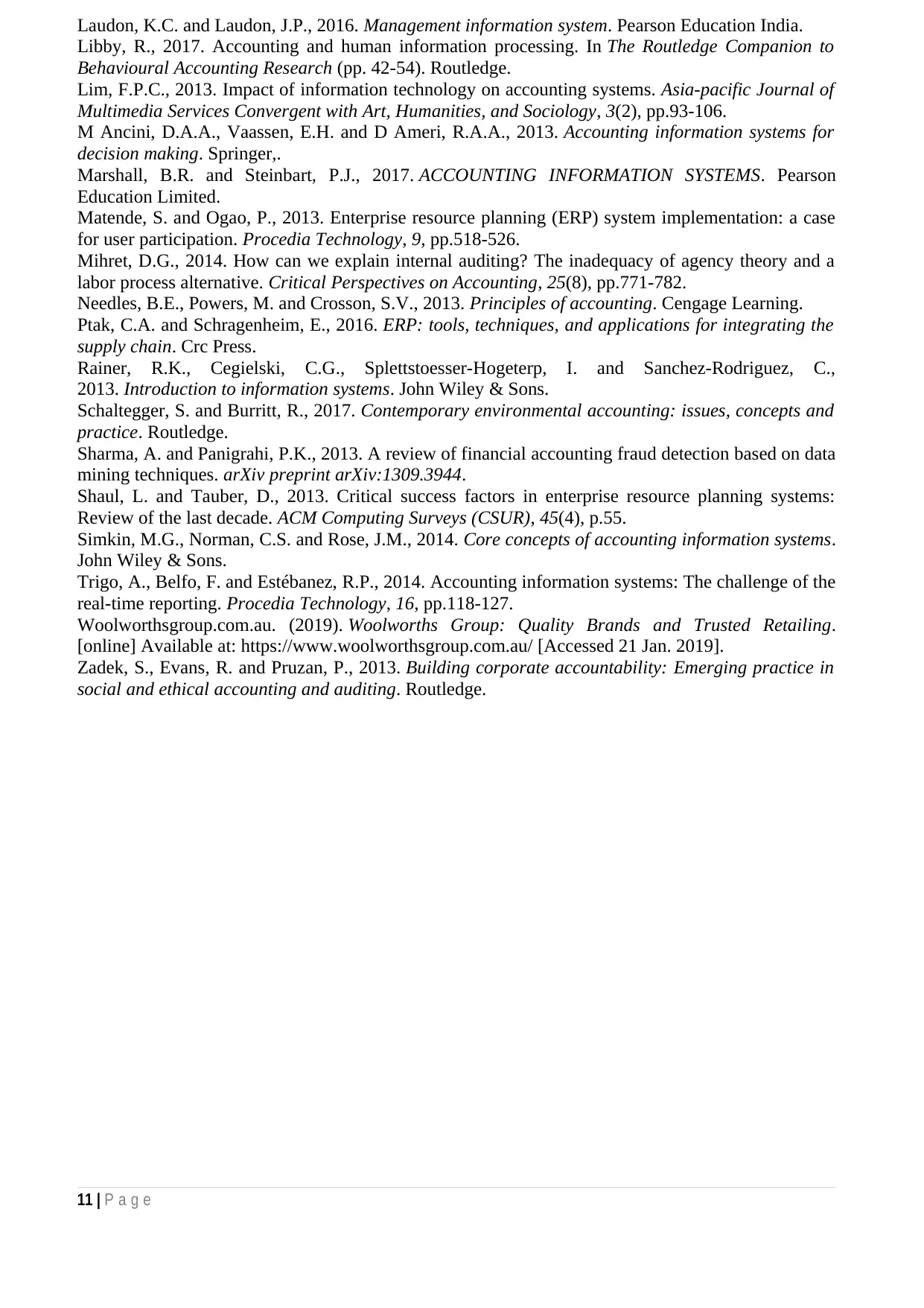
Laudon, K.C. and Laudon, J.P., 2016. Management information system. Pearson Education India.
Libby, R., 2017. Accounting and human information processing. In The Routledge Companion to
Behavioural Accounting Research (pp. 42-54). Routledge.
Lim, F.P.C., 2013. Impact of information technology on accounting systems. Asia-pacific Journal of
Multimedia Services Convergent with Art, Humanities, and Sociology, 3(2), pp.93-106.
M Ancini, D.A.A., Vaassen, E.H. and D Ameri, R.A.A., 2013. Accounting information systems for
decision making. Springer,.
Marshall, B.R. and Steinbart, P.J., 2017. ACCOUNTING INFORMATION SYSTEMS. Pearson
Education Limited.
Matende, S. and Ogao, P., 2013. Enterprise resource planning (ERP) system implementation: a case
for user participation. Procedia Technology, 9, pp.518-526.
Mihret, D.G., 2014. How can we explain internal auditing? The inadequacy of agency theory and a
labor process alternative. Critical Perspectives on Accounting, 25(8), pp.771-782.
Needles, B.E., Powers, M. and Crosson, S.V., 2013. Principles of accounting. Cengage Learning.
Ptak, C.A. and Schragenheim, E., 2016. ERP: tools, techniques, and applications for integrating the
supply chain. Crc Press.
Rainer, R.K., Cegielski, C.G., Splettstoesser-Hogeterp, I. and Sanchez-Rodriguez, C.,
2013. Introduction to information systems. John Wiley & Sons.
Schaltegger, S. and Burritt, R., 2017. Contemporary environmental accounting: issues, concepts and
practice. Routledge.
Sharma, A. and Panigrahi, P.K., 2013. A review of financial accounting fraud detection based on data
mining techniques. arXiv preprint arXiv:1309.3944.
Shaul, L. and Tauber, D., 2013. Critical success factors in enterprise resource planning systems:
Review of the last decade. ACM Computing Surveys (CSUR), 45(4), p.55.
Simkin, M.G., Norman, C.S. and Rose, J.M., 2014. Core concepts of accounting information systems.
John Wiley & Sons.
Trigo, A., Belfo, F. and Estébanez, R.P., 2014. Accounting information systems: The challenge of the
real-time reporting. Procedia Technology, 16, pp.118-127.
Woolworthsgroup.com.au. (2019). Woolworths Group: Quality Brands and Trusted Retailing.
[online] Available at: https://www.woolworthsgroup.com.au/ [Accessed 21 Jan. 2019].
Zadek, S., Evans, R. and Pruzan, P., 2013. Building corporate accountability: Emerging practice in
social and ethical accounting and auditing. Routledge.
11 | P a g e
Libby, R., 2017. Accounting and human information processing. In The Routledge Companion to
Behavioural Accounting Research (pp. 42-54). Routledge.
Lim, F.P.C., 2013. Impact of information technology on accounting systems. Asia-pacific Journal of
Multimedia Services Convergent with Art, Humanities, and Sociology, 3(2), pp.93-106.
M Ancini, D.A.A., Vaassen, E.H. and D Ameri, R.A.A., 2013. Accounting information systems for
decision making. Springer,.
Marshall, B.R. and Steinbart, P.J., 2017. ACCOUNTING INFORMATION SYSTEMS. Pearson
Education Limited.
Matende, S. and Ogao, P., 2013. Enterprise resource planning (ERP) system implementation: a case
for user participation. Procedia Technology, 9, pp.518-526.
Mihret, D.G., 2014. How can we explain internal auditing? The inadequacy of agency theory and a
labor process alternative. Critical Perspectives on Accounting, 25(8), pp.771-782.
Needles, B.E., Powers, M. and Crosson, S.V., 2013. Principles of accounting. Cengage Learning.
Ptak, C.A. and Schragenheim, E., 2016. ERP: tools, techniques, and applications for integrating the
supply chain. Crc Press.
Rainer, R.K., Cegielski, C.G., Splettstoesser-Hogeterp, I. and Sanchez-Rodriguez, C.,
2013. Introduction to information systems. John Wiley & Sons.
Schaltegger, S. and Burritt, R., 2017. Contemporary environmental accounting: issues, concepts and
practice. Routledge.
Sharma, A. and Panigrahi, P.K., 2013. A review of financial accounting fraud detection based on data
mining techniques. arXiv preprint arXiv:1309.3944.
Shaul, L. and Tauber, D., 2013. Critical success factors in enterprise resource planning systems:
Review of the last decade. ACM Computing Surveys (CSUR), 45(4), p.55.
Simkin, M.G., Norman, C.S. and Rose, J.M., 2014. Core concepts of accounting information systems.
John Wiley & Sons.
Trigo, A., Belfo, F. and Estébanez, R.P., 2014. Accounting information systems: The challenge of the
real-time reporting. Procedia Technology, 16, pp.118-127.
Woolworthsgroup.com.au. (2019). Woolworths Group: Quality Brands and Trusted Retailing.
[online] Available at: https://www.woolworthsgroup.com.au/ [Accessed 21 Jan. 2019].
Zadek, S., Evans, R. and Pruzan, P., 2013. Building corporate accountability: Emerging practice in
social and ethical accounting and auditing. Routledge.
11 | P a g e
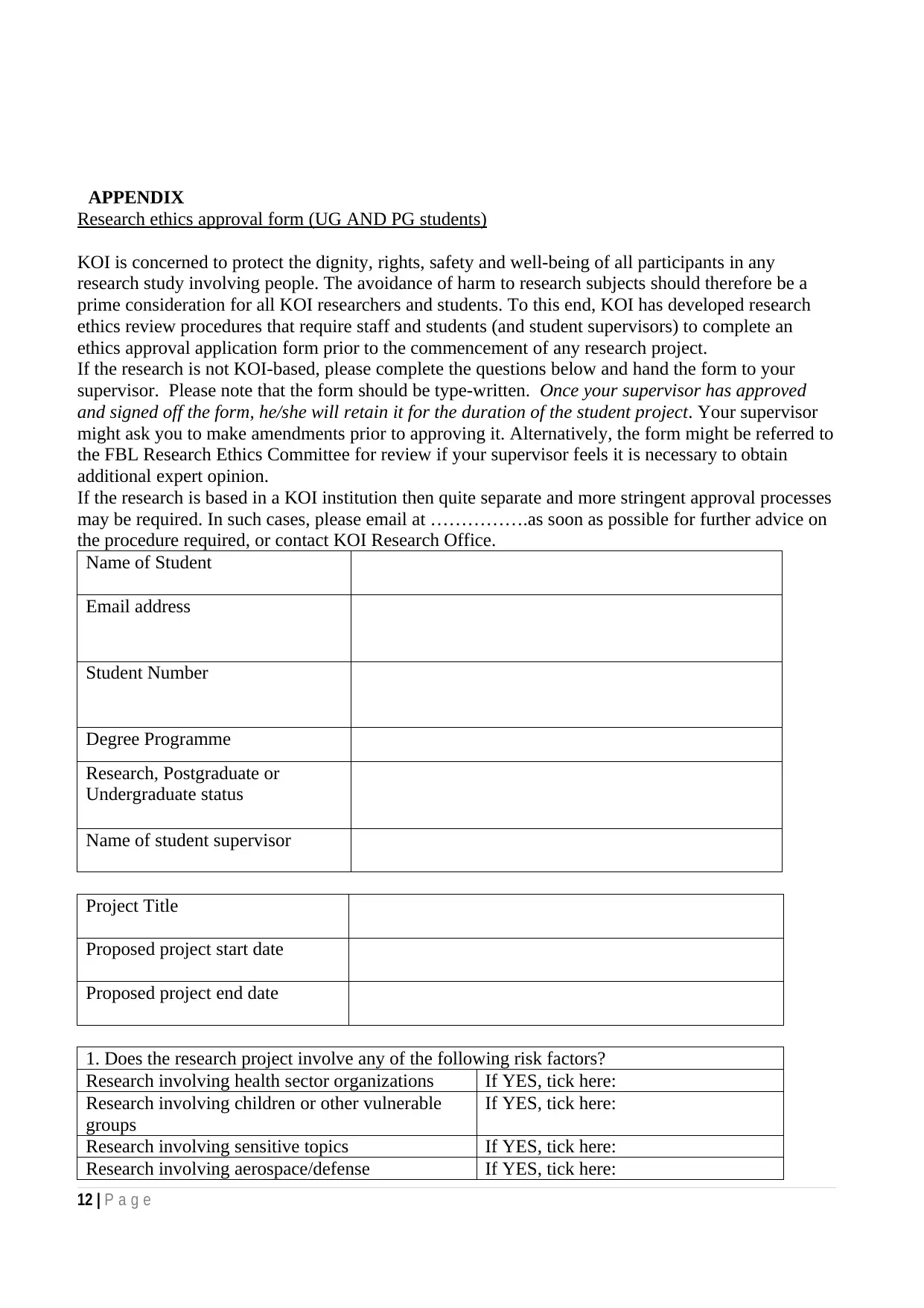
APPENDIX
Research ethics approval form (UG AND PG students)
KOI is concerned to protect the dignity, rights, safety and well-being of all participants in any
research study involving people. The avoidance of harm to research subjects should therefore be a
prime consideration for all KOI researchers and students. To this end, KOI has developed research
ethics review procedures that require staff and students (and student supervisors) to complete an
ethics approval application form prior to the commencement of any research project.
If the research is not KOI-based, please complete the questions below and hand the form to your
supervisor. Please note that the form should be type-written. Once your supervisor has approved
and signed off the form, he/she will retain it for the duration of the student project. Your supervisor
might ask you to make amendments prior to approving it. Alternatively, the form might be referred to
the FBL Research Ethics Committee for review if your supervisor feels it is necessary to obtain
additional expert opinion.
If the research is based in a KOI institution then quite separate and more stringent approval processes
may be required. In such cases, please email at …………….as soon as possible for further advice on
the procedure required, or contact KOI Research Office.
Name of Student
Email address
Student Number
Degree Programme
Research, Postgraduate or
Undergraduate status
Name of student supervisor
Project Title
Proposed project start date
Proposed project end date
1. Does the research project involve any of the following risk factors?
Research involving health sector organizations If YES, tick here:
Research involving children or other vulnerable
groups
If YES, tick here:
Research involving sensitive topics If YES, tick here:
Research involving aerospace/defense If YES, tick here:
12 | P a g e
Research ethics approval form (UG AND PG students)
KOI is concerned to protect the dignity, rights, safety and well-being of all participants in any
research study involving people. The avoidance of harm to research subjects should therefore be a
prime consideration for all KOI researchers and students. To this end, KOI has developed research
ethics review procedures that require staff and students (and student supervisors) to complete an
ethics approval application form prior to the commencement of any research project.
If the research is not KOI-based, please complete the questions below and hand the form to your
supervisor. Please note that the form should be type-written. Once your supervisor has approved
and signed off the form, he/she will retain it for the duration of the student project. Your supervisor
might ask you to make amendments prior to approving it. Alternatively, the form might be referred to
the FBL Research Ethics Committee for review if your supervisor feels it is necessary to obtain
additional expert opinion.
If the research is based in a KOI institution then quite separate and more stringent approval processes
may be required. In such cases, please email at …………….as soon as possible for further advice on
the procedure required, or contact KOI Research Office.
Name of Student
Email address
Student Number
Degree Programme
Research, Postgraduate or
Undergraduate status
Name of student supervisor
Project Title
Proposed project start date
Proposed project end date
1. Does the research project involve any of the following risk factors?
Research involving health sector organizations If YES, tick here:
Research involving children or other vulnerable
groups
If YES, tick here:
Research involving sensitive topics If YES, tick here:
Research involving aerospace/defense If YES, tick here:
12 | P a g e
⊘ This is a preview!⊘
Do you want full access?
Subscribe today to unlock all pages.

Trusted by 1+ million students worldwide
1 out of 13
Related Documents
Your All-in-One AI-Powered Toolkit for Academic Success.
+13062052269
info@desklib.com
Available 24*7 on WhatsApp / Email
![[object Object]](/_next/static/media/star-bottom.7253800d.svg)
Unlock your academic potential
Copyright © 2020–2025 A2Z Services. All Rights Reserved. Developed and managed by ZUCOL.





